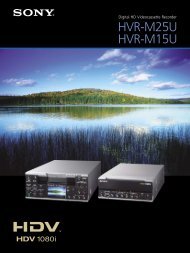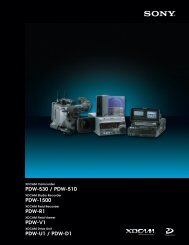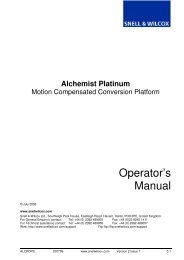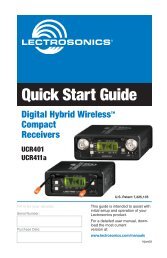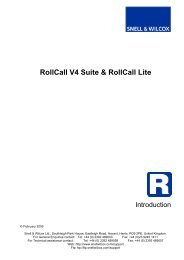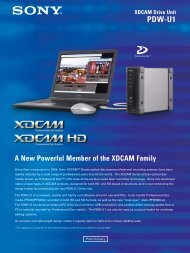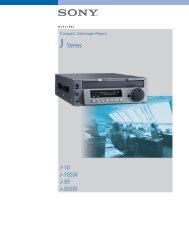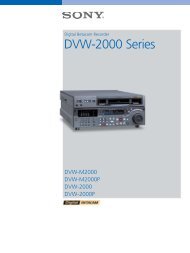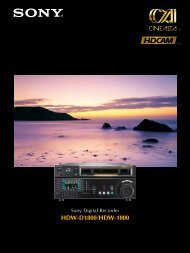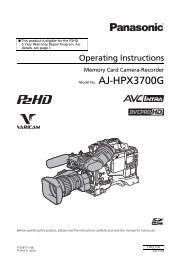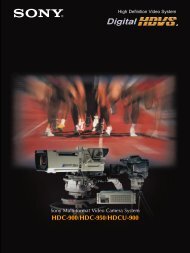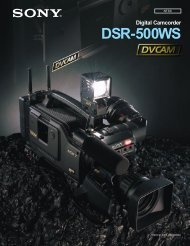HD-Connect MI manual - Convergent Design, experts in HDMI, SD ...
HD-Connect MI manual - Convergent Design, experts in HDMI, SD ...
HD-Connect MI manual - Convergent Design, experts in HDMI, SD ...
You also want an ePaper? Increase the reach of your titles
YUMPU automatically turns print PDFs into web optimized ePapers that Google loves.
may be necessary to set a timecode offset <strong>in</strong> the capture application to<br />
ensure that the logged DV <strong>in</strong>po<strong>in</strong>ts and outpo<strong>in</strong>ts correspond to the<br />
correct frames dur<strong>in</strong>g f<strong>in</strong>al onl<strong>in</strong>e capture through <strong>HD</strong>-<strong>Connect</strong> <strong>MI</strong>. In<br />
addition, some <strong>HD</strong>V devices will not down-convert to <strong>SD</strong> and provide a<br />
DV output, so this scenario would not be possible with all <strong>HD</strong>V devices.<br />
While the need for an <strong>SD</strong>I capture card (<strong>HD</strong> or <strong>SD</strong>) <strong>in</strong> the <strong>SD</strong>I scenario<br />
elim<strong>in</strong>ates the possibility of captur<strong>in</strong>g and edit<strong>in</strong>g on a laptop or with<br />
Avid Xpress Pro, the <strong>SD</strong>I offl<strong>in</strong>e/onl<strong>in</strong>e scenario elim<strong>in</strong>ates the<br />
difference <strong>in</strong> timecode source, s<strong>in</strong>ce clips are captured through <strong>HD</strong>-<br />
<strong>Connect</strong> <strong>MI</strong> at both offl<strong>in</strong>e and onl<strong>in</strong>e stages. Also, the <strong>SD</strong>I scenario<br />
allows the selection of a number of different codecs for video<br />
compression dur<strong>in</strong>g the offl<strong>in</strong>e tape capture. With <strong>SD</strong>-<strong>SD</strong>I output from<br />
<strong>HD</strong>-<strong>Connect</strong> <strong>MI</strong> set <strong>in</strong> <strong>SD</strong> mode, a software DV codec could achieve<br />
the same sav<strong>in</strong>gs <strong>in</strong> disk space as <strong>in</strong> the DV scenario. For higherquality<br />
material dur<strong>in</strong>g offl<strong>in</strong>e capture and edit, <strong>HD</strong>-<strong>Connect</strong> <strong>MI</strong> could<br />
be set <strong>in</strong> <strong>HD</strong> mode and a DVC-Pro-<strong>HD</strong> or DNx<strong>HD</strong> codec used to<br />
compress captured video. Recapture of just the f<strong>in</strong>al project clips could<br />
then be done at the full <strong>HD</strong> data rate. The <strong>SD</strong>I scenario is also more<br />
universal than the DV scenario, s<strong>in</strong>ce it covers an <strong>HD</strong>V source such as<br />
the JVC BR-<strong>HD</strong>50 deck that do not down-convert to DV.<br />
The table below summarizes the advantages and disadvantages of the<br />
DV and <strong>SD</strong>I scenarios.<br />
Advantages<br />
DV Offl<strong>in</strong>e Capture<br />
• Laptop ok<br />
• Avid Xpress Pro ok<br />
• M<strong>in</strong>imal equipment<br />
• Low data rate<br />
<strong>SD</strong>I Offl<strong>in</strong>e Capture<br />
• <strong>SD</strong> or <strong>HD</strong><br />
• Choice of <strong>SD</strong> or <strong>HD</strong><br />
codecs (DV, DVC Pro <strong>HD</strong>,<br />
etc.)<br />
• Ok for <strong>HD</strong>V device<br />
without down-conversion<br />
Disadvantages<br />
• Lower offl<strong>in</strong>e quality<br />
• <strong>SD</strong> only<br />
• DV compression only<br />
• May need timecode<br />
offset <strong>in</strong> edit app<br />
• Requires <strong>HD</strong>V<br />
• No laptop<br />
• No Xpress Pro<br />
<strong>HD</strong>-<strong>Connect</strong> <strong>MI</strong> Guide and User’s Manual.<br />
25



